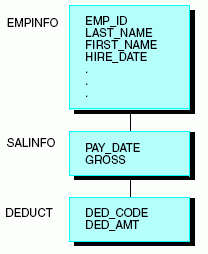Logical Dependence: The Parent-Child Relationship
Logical dependence between segments is expressed in
terms of the parent-child relationship. A child segment is dependent
upon its parent segment. An instance of the child segment can exist
only if a related instance of the parent segment exists. The parent
segment has logical precedence in the relationship, and is retrieved
first when the data source is accessed.
Note that if the parent-child relationship is logical and not
physical, as in the case of a join, it is possible to have a child
instance without a related parent instance. In this case, the child
instance is not accessible through the join, although it is still
accessible independently.
If a join relates the parent-child segments, the parent is known
as the host segment, and the child is known as the cross-referenced
segment. The fields on which the join is based (that is, the matching
fields in the host and cross-referenced segments) are known respectively
as the host and cross-referenced fields.
xA Simple Parent-Child Relationship
In the EMPLOYEE data source, the EMPINFO and SALINFO
segments are related. EMPINFO identifies an employee by ID number,
while SALINFO contains the pay history of the employee. EMPINFO
is the parent segment, and SALINFO is a child segment dependent
upon it. It is possible to have in this relationship an employee
identified by ID and name for whom no salary information has been
entered (that is, the parent instance without the child instance).
However, it is meaningless to have salary information for an employee
if one does not know who the employee is (that is, a child instance
without the parent instance).
The following diagram illustrates the concept of a parent-child
relationship.
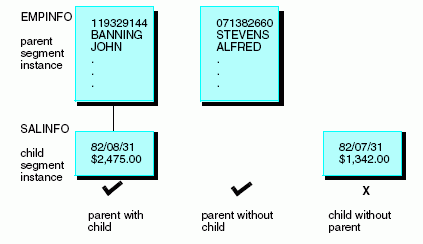
xA Parent-Child Relationship With Multiple Segments
The same general parent-child relationships hold for
data structures containing more than two segments. Consider the
following diagram of a portion of the EMPLOYEE data source, containing
the EMPINFO, SALINFO, and DEDUCT segments. DEDUCT contains payroll
deduction information for each paycheck.
The following diagram illustrates the concept of a parent-child
relationship with multiple segments.
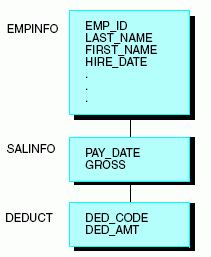
EMPINFO is related to SALINFO, and in this relationship EMPINFO
is the parent segment and SALINFO is the child segment. SALINFO
is also related to DEDUCT. In this second relationship, SALINFO
is the parent segment and DEDUCT is the child segment. Just as SALINFO
is dependent upon EMPINFO, DEDUCT is dependent upon SALINFO.
xUnderstanding a Root Segment
The segment that has logical precedence over the entire
data structure, the parent of the entire structure, is called the root segment.
This is because a data structure can branch like a tree, and the
root segment, like the root of a tree, is the source of the structure.
In the following diagram, EMPINFO is the root. It has no parent,
and all other segments in the structure are its children, directly
(SALINFO) or indirectly (DEDUCT).
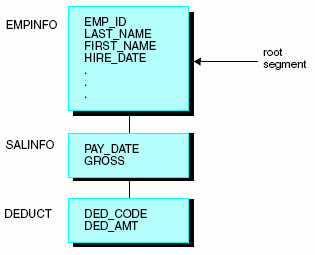
xUnderstanding a Descendant Segment
Direct and indirect children of a segment are collectively
known as its descendant segments. SALINFO and DEDUCT are descendants
of EMPINFO. DEDUCT is also a descendant of SALINFO. A descendant
segment with no children is called a leaf segment, because
the branching of the data structure tree ends with the leaf. DEDUCT
is a leaf.
The following diagram illustrates the concept of a descendant
segment.
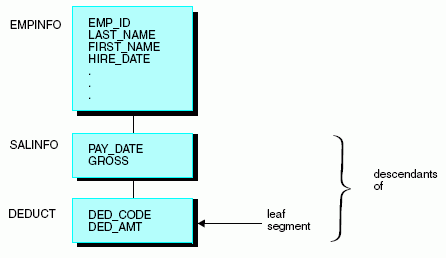
xUnderstanding an Ancestral Segment
Direct and indirect parents
of a segment are its ancestral segments. In the following diagram,
SALINFO and EMPINFO are ancestors of DEDUCT.
